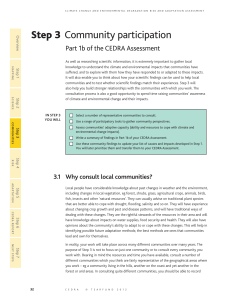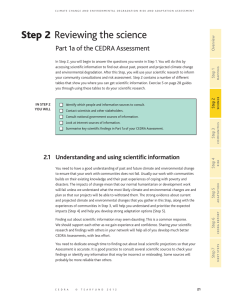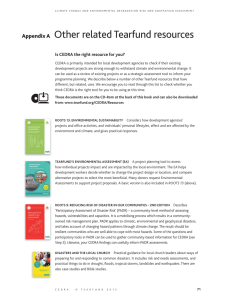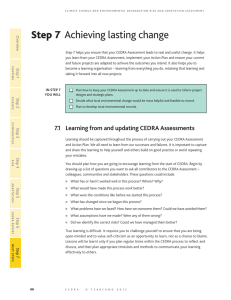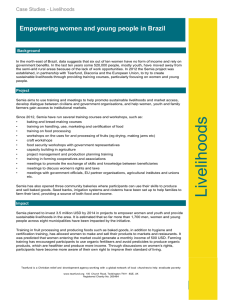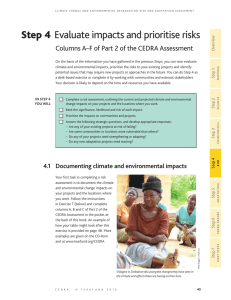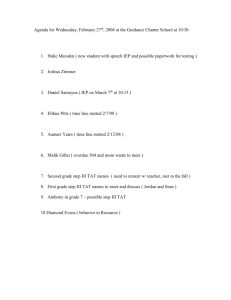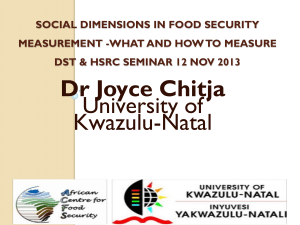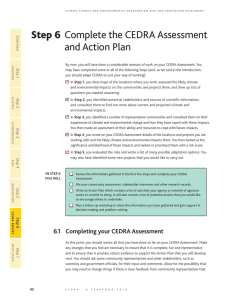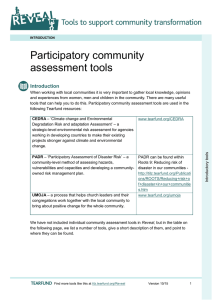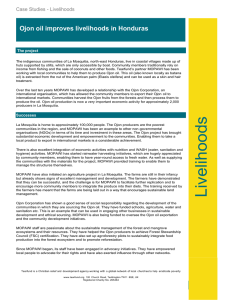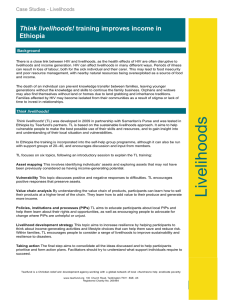Document 10772313
advertisement
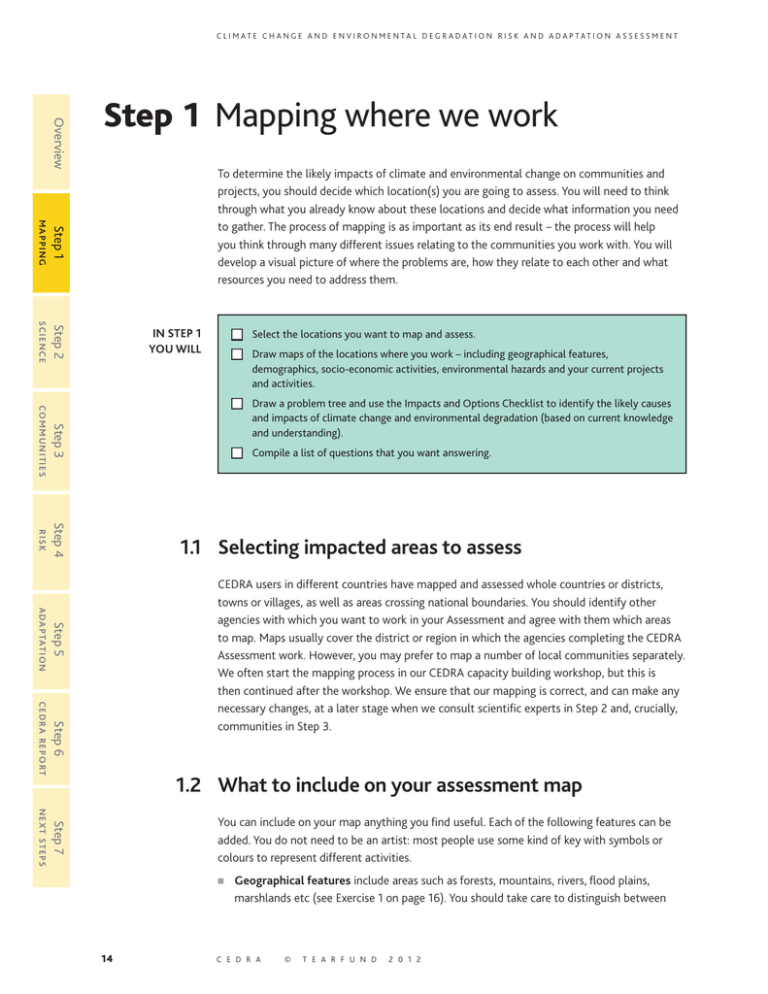
C L I M AT E C H A N G E A N D E N V I RO N M E N TA L D E G R A DAT I O N R I S K A N D A DA P TAT I O N A S S E S S M E N T Overview Step 1 Mapping where we work MA P PING Step 1 SC IENCE Step 2 To determine the likely impacts of climate and environmental change on communities and projects, you should decide which location(s) you are going to assess. You will need to think through what you already know about these locations and decide what information you need to gather. The process of mapping is as important as its end result – the process will help you think through many different issues relating to the communities you work with. You will develop a visual picture of where the problems are, how they relate to each other and what resources you need to address them. IN STEP 1 YOU WILL ■ Select the locations you want to map and assess. ■ Draw maps of the locations where you work – including geographical features, demographics, socio-economic activities, environmental hazards and your current projects and activities. CO MMUNI TIE S Step 3 R ISK Step 4 ■ Draw a problem tree and use the Impacts and Options Checklist to identify the likely causes and impacts of climate change and environmental degradation (based on current knowledge and understanding). ■ Compile a list of questions that you want answering. 1.1 Selecting impacted areas to assess A DA PTATIO N Step 5 C ED R A R EPO RT Step 6 CEDRA users in different countries have mapped and assessed whole countries or districts, towns or villages, as well as areas crossing national boundaries. You should identify other agencies with which you want to work in your Assessment and agree with them which areas to map. Maps usually cover the district or region in which the agencies completing the CEDRA Assessment work. However, you may prefer to map a number of local communities separately. We often start the mapping process in our CEDRA capacity building workshop, but this is then continued after the workshop. We ensure that our mapping is correct, and can make any necessary changes, at a later stage when we consult scientific experts in Step 2 and, crucially, communities in Step 3. 1.2 What to include on your assessment map Step 7 NEXT ST EPS You can include on your map anything you find useful. Each of the following features can be added. You do not need to be an artist: most people use some kind of key with symbols or colours to represent different activities. ■ 14 Geographical features include areas such as forests, mountains, rivers, flood plains, marshlands etc (see Exercise 1 on page 16). You should take care to distinguish between C E D R A © T E A R F U N D 2 0 1 2 C L I M AT E C H A N G E A N D E N V I RO N M E N TA L D E G R A DAT I O N R I S K A N D A DA P TAT I O N A S S E S S M E N T C E D R A © T E A R F U N D 2 0 1 2 Step 1 MA P PING S CIE NCE Step 2 Step 3 15 CO MMUNI TIE S Projects and activities being undertaken by communities, yourself and other stakeholders can now be added to the map. These may cause, contribute to or reduce hazards – for example, cutting timber can contribute to loss of water resources or landslides. Flood diversion projects can unintentionally move the flood risk to impact other communities. R IS K ■ Step 4 Environmental hazards threatening different geographical locations will have to be assessed, unless the physical geography is similar throughout the country or region. You will need also to think through their different impacts on men and women. Some of the hazards may have become obvious as you have added features to the map. Others you may presume or guess at from experience, such as the likelihood of landslides in deforested hilly areas. Some hazards you may be unaware of at this stage, and you will have to add them in later, after consulting communities and other external stakeholders. Step 5 ■ ADA P TATIO N Power dynamics between women and men, and their impact on children, should be mapped, considering issues such as access, control and decisionmaking. Women usually have the least access to natural resources and land, and the least control and power to make decisions. Yet, women Children map their community, Caracol, Honduras. make up the majority of agricultural workers and are generally more dependent on natural resources than men for the provision of food, water, fuel and herbal medicines. Step 6 ■ C ED R A R EPO RT Socio-economic activities can be mapped to help us understand further how women, men and children interact with the environment. For example, local industry is likely to use local natural resources such as water, timber, clay or metals. Local livelihoods are likely to affect local biodiversity through activities such as agriculture, fishing or deforestation. Step 7 ■ NEXT S TEP S Demographic information shows where different people groups live and their different activities. This will help us begin to map their activities and understand how they interact with the environment. It is important to think about the different roles women and men play and the different work and tasks they undertake, as well as about children’s activities. Mike Wiggins / Tearfund ■ Overview them. This stage of the mapping exercise will help later when you identify environmental hazards because they can be specific to particular locations. For example, hilly areas may face landslides, coastal areas suffer increased soil salinity etc. By contrast, some impacts, such as the increased severity of cyclones, can affect one or several countries. Try also to identify positive features such as higher ground not susceptible to flooding, a district capital with a hospital, good communication links etc. C L I M AT E C H A N G E A N D E N V I RO N M E N TA L D E G R A DAT I O N R I S K A N D A DA P TAT I O N A S S E S S M E N T Overview Exercise 1 Draw your assessment map Discuss the locations where you work and select an area you want to map. Draw your map, with reference to official maps of the area. If this is a map of a town or district, it is good to consult local community members, or even to invite them to draw the map. If you are drawing many towns or villages or a national map, it is good to get the input of other stakeholders, such as local or national government members, other NGOs, universities or scientists. Ensure you have added all the different geographical features, such as: Step 1 MA P PING SC IENCE Step 2 CO MMUNI TIE S Step 3 R ISK Step 4 A DA PTATIO N Step 5 C ED RA R EP O RT Step 6 NEXT STEPS Step 7 ■ coastal ■ highlands ■ semi-arid or steppe ■ wetlands ■ mid-altitude ■ tundra ■ dry/arid/desert ■ lowlands ■ grasslands ■ arable land ■ forests ■ savannah ■ flood-plains ■ cloud forest ■ town or city ■ lakelands ■ rainforests ■ urban settlements Now, add the other features – demographics, socio-economic activities etc – as described above. Example Assessment map Tearfund partners in the Aru Diocese of Democratic Republic of Congo decided to work together on a CEDRA Assessment. Aru, in the north-east of the country, is in Ituri District in Orientale Province. The partners produced the map shown here. NOTE examples Additional be found of maps can panying m co on the ac downCD-Rom or our m o fr ed load .tearfund. w w w : te si web aps /M org/CEDRA 16 C E D R A © T E A R F U N D 2 0 1 2 C L I M AT E C H A N G E A N D E N V I RO N M E N TA L D E G R A DAT I O N R I S K A N D A DA P TAT I O N A S S E S S M E N T Step 1 Step 3 This problem tree was devised by Tearfund partners in the Diocese of Aru, DRC. CO MMUNI TIES Problem tree © T E A R F U N D Step 4 2 0 1 2 17 Step 6 CE DR A R EP O RT Step 5 C E D R A Step 7 Many CEDRA users refer extensively to the climate and environmental Impacts and Options Checklist (in the pocket at the back of this book) when thinking through climate change impacts. Doing so helps them write a fuller list of likely impacts and a list of questions for communities and other stakeholders. ADA P TATIO N eples of caus More exam em bl o pr and-impact found on trees can be . or at: www the CD-Rom / A R /CED tearfund.org s ct pa m sI se Cau R IS K NOTE NEXT S TEP S Example Step 2 Many people use a problem tree to explore the causes and impacts of climate change and environmental degradation. Importantly, it shows the linkages between root causes and problems. An example is given below from the Diocese of Aru, DRC. The problem tree is typically drawn in the way described in Exercise 2 (below). S CIE NCE As we saw above, different climate- and environment-related hazards will affect different areas in different ways. You have added some of these to your initial map. It is useful at this stage to consider what you believe future climate and environmental hazards are likely to be. It is important to note that this is an initial assessment based on your current knowledge, to help prepare you to research the issues in more depth. In the following Steps, you will research scientific information and community perspectives on these issues. MA P PING Overview 1.3 Causes and impacts of climate and environmental change C L I M AT E C H A N G E A N D E N V I RO N M E N TA L D E G R A DAT I O N R I S K A N D A DA P TAT I O N A S S E S S M E N T Overview It is important to consider how impacts affect women and men differently. For example, when a shortage of rain leads to less fresh water, women’s workload is increased as they have to walk further to fetch water. Children, especially girls, are particularly vulnerable to the impacts of climate and environmental change such as diarrhoea, malaria, malnutrition and reduced access to education. It is important to take gender and age into consideration when considering impacts, at every stage of the CEDRA process. Step 1 MA P PING Exercise 2 Climate and environmental causes and impacts Step 3 CO MMUNI TIE S Step 4 R ISK Develop a problem tree. Start by drawing a tree trunk and write on it the problem you are considering. In this case, we are thinking about environmental degradation, including climate change. ■ Now, list all the causes of environmental degradation and climate change that you can think of and draw these as the roots. Depending on how large an area your map covers, there could be many causes, so it may be useful to group the causes into categories (such as agriculture, fuel etc) by drawing sub-roots off the roots. For each cause, ask the question ‘why’ to identify further causes. At this stage, you are just mapping the possible or suspected impacts. You will verify them later. ■ In a similar way, the impacts are drawn as branches on the tree. You may find it useful to group these impacts by drawing twigs on the branches. ■ Some people also draw fruit on the tree, which represent the consequences of the impacts. For example, an impact category could be flooding: this could be split into health, food and infrastructure impacts. A ‘fruit’ of the health impacts could be an increase in waterborne diseases. ■ Use the climate and environmental Impacts and Options Checklist (in the pocket at the back of this book) to think through further likely impacts of climate and environmental change. This is just an initial exercise to consider what the impacts might be. Your research in Steps 2 and 3 will confirm them. Step 2 SC IENCE ■ While completing this by yourselves in a workshop setting, it should also be completed by different community focus groups. To use the checklist, ignore the right-hand column at this stage. You will refer to this later. The first narrow column has categories of impacts written on the side of the table, such as land, health, water, agriculture. Look down this column and select the appropriate part of the table. Tick any impacts which may affect your projects. Underline text which you think best applies to your locations. Most people also add other impacts. If you are not sure, then tick impacts for now and check them later. Many will not be relevant to you: just ignore them or cross them out. Do this for each of the different locations in which you work (see Section 1.1). ■ Add the impacts from the checklist to your problem tree if you like. Or you can keep the two separate. You will use these to develop the list of questions you want answered in the next exercise. Step 5 A DA PTATIO N ■ C ED RA R EP O RT Step 6 NEXT STEPS Step 7 18 C E D R A © T E A R F U N D 2 0 1 2 C L I M AT E C H A N G E A N D E N V I RO N M E N TA L D E G R A DAT I O N R I S K A N D A DA P TAT I O N A S S E S S M E N T Devised by Tearfund partners in the Diocese of Aru, DRC. Examples of climate and environmental impacts Examples of adaptation options (Add your own) ✓Rural livelihood failure from extreme Preparing for uncertainty Mutual assistance systems and social networks for risk reduction Rural access to urban market pricing data Alternative livelihoods training diversification and over-emphasis on a single activity, eg rain-fed agriculture Urban livelihoods training including renewable energy, sustainable construction, waste recycling Livelihood failure from poor access to alternative resources, technologies, skills and financial reserves Improved local record-keeping environmental out how change and nonab IInformatio livelihood impacts hand changing weather patterns and crop failure impacts Urban work places destroyed by flooding or landslides Livelihood failure leading to people engaging in unsafe livelihood activities or hazard-vulnerable activities Livelihood failure preventing loan repayments Urban over-population from excessive urban migration as a result of failure of rural livelihoods NO the righte Impa n Permaculture / intercropping colum of th Checklist is and Options ep 5. Strengthening livelihoods St provided in Step 2 ✓Agricultural livelihoods fail from Education and awareness-raising TE e uscultural to on Awareness-raising customs andct practices s Skills training in income-generation methods Market gardening Micro-finance initiatives to support alternative income-generation Community accessible micro-insurance Step 3 ✓Livelihood failure from lack of Livelihoods Step 1 Livelihood failure from natural resource and biodiversity loss Inter-community knowledge transfer visits S CIE NCE weather, flooding, drought, cyclones, storms, temperature rise, disease MA P PING Overview Impacts and Options Checklist Livelihood diversification Support diversified household and community asset bases Improve market access and direct engagement Community-led agriculture: eg organic cooperatives, farm shares CO MMUNI TIES Example Moving ‘up the value chain’ with higher-value processing and marketing of crops Step 4 R IS K Entrepreneurs grants, loans and awards Micro-finance, cash transfer, credit and loan guarantees available to C E D R A © T E A R F U N D 2 0 1 2 19 Step 6 CE DR A R EP O RT Step 7 NEXT S TEP S Step 5 You will by now have written a long list of possible climate and environmental hazards facing your communities or projects. However, you will probably have very little information about the scale of these impacts or their relative significance. You are also unlikely to have much information about how these impacts have changed over time or may change in the future. It is therefore helpful at this point to write a list of questions you would like answering to help you understand the extent of climate and environmental impacts in the areas you have mapped. ADA P TATIO N 1.4 Compile a list of questions that you want answered C L I M AT E C H A N G E A N D E N V I RO N M E N TA L D E G R A DAT I O N R I S K A N D A DA P TAT I O N A S S E S S M E N T Overview Exercise 3 For each of the geographical areas you have drawn on your map, write a list of questions relevant to the climate and environmental impacts you identified above. You may find that some of the questions are the same for different areas, which will reduce the amount of research needed. It is important, however, to make sure you collect all the information needed for each place where you work. Write a list of questions you want answered Step 1 MA P PING The questions you write can be put to different communities and other stakeholders that you will identify in Step 2. You will probably be surprised by the amount of information others have to answer your questions easily and thoroughly. In the pocket at the back of this book, we have included a longer list of possible questions to which you can refer in drawing up your own list. This form also includes columns to record different stakeholders’ answers. You will not need all of these questions and you will probably want to add some of your own, related to the possible impacts you identified or were unsure about in Exercise 2. Step 2 SC IENCE There is a good and more comprehensive list of questions we could use when meeting with scientists and national meteorological offices developed by the Red Cross Climate Centre, at: http://www.climatecentre.org/downloads/File/Stakeholders%20Analysis.pdf Step 3 CO MMUNI TIE S An extract of the list of questions provided at the back of this book is shown below. Some of the CEDRA Community and Stakeholder Questions Questions Answers Sources How would you define climate change? R ISK Step 4 What climate change impacts have already impacted our country / district / location? • Do you have any evidence / records of these impacts? How would you define environmental degradation? What environmental degradation impacts have already impacted our country / district / location? • Do you have any evidence / records of these impacts? Step 5 A DA PTATIO N Do you have information about past and present changes regarding the following? • Annual and seasonal rainfall – amount, duration • Annual and seasonal average temperatures • Annual and seasonal average storms – frequency, Step 6 C ED RA R EP O RT We recommend that you share your maps, likely impacts and list of questions with others in your network, so you can help and support each other in your CEDRA Assessments. Questions for reflection and learning: Step 7 NEXT STEPS 20 ■ What have you learnt as you’ve carried out this Step? ■ Have you achieved what you set out to do when you started? ■ Is there anything you need to change in your approach as you address the other Steps? ■ Are there skills you’ve learnt that could be useful to pass on to others in your organisation? ■ How can you feed back your learning into your annual planning cycle and organisational strategy / strategic review? C E D R A © T E A R F U N D 2 0 1 2
